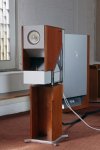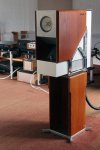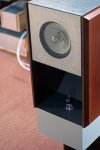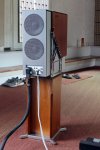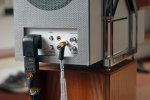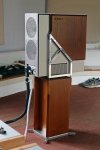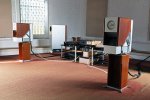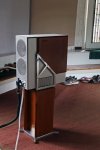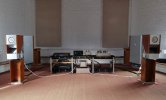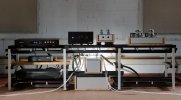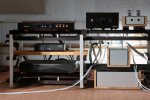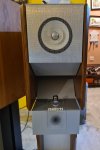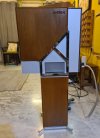I had gone over to the Rethm Studio to listen to the Aarkas again. This time, I was able to listen to the final production version. There were quite a few changes from the last time I had listened to them: The tube in the preamp section was different, and the bass section was different.
The studio is a rather large pentagonal room (stretched lengthwise). The speaker was about 9 feet away from the wall behind it, and the listening position was about 9 feet away from the speaker. The final Steel stands were not yet ready, and the speaker was set up on the older version wood stands.
The source chain was an Innuos Server playing Tidal via Roon, connected via IIS to a Singxer USBridge, outputting signal to a Holo Audio Spring DAC via Coaxial. The Aarkas were connected via RCA interconnects from the DAC.
As before, the typical Rethm traits were all there: natural and open tone, very wide and deep soundstage, and pin-point imaging. This time however, the improvement in the midrange and and bass section was very noticeable. In comparison to my Trishnas, the top end is ever so slightly rolled off, and the Aarkas run circles around the Trishna when it comes to bass response! In fact, the Aarkas sound dangerously close to how I have my Trishnas set up with a REL T5/i! The bass is fast and quite palpable. The mids have that perfect balance between feeling liquidly flowing and biting hard when necessary. Because of the expansive soundstage, they sound like big speakers. It's actually hard to believe that speakers of this size can put out a wall of sound that's this big!
There was plenty of bass for my taste in that large room, but I'd wager that these speakers would sound somewhat better in a smaller room.
The Aarkas have a bass level control, and a crossover control in the back, with the RCA inputs, the external amplification switch, and banana plus inputs for when that switch is used. The bass level and crossover controls should help us set us the Aarkas in any room, and also compensate for a wall being close to their rear.
The speakers are priced at 1.5L plus GST (@18% currently), without the stands. (The stands are priced and sold as separate items, and I'm not sure how much the stands come to, since they're still to finish production of the stands).
As someone who owns virtually a full Rethm setup (speakers/amp/speakers cables), and as someone who's listened (multiple times and in multiple rooms in some cases, over the last 8 years or so) to two generations of Bhaavas, Maargas, and Saadhanas, IMHO, these are great value for that price.
I've attached a few photos to this post. Trust me, photos do no justice to these works of art! The design and the proportions of these speakers make it hard to take our eyes off them.
www.schiit.com


